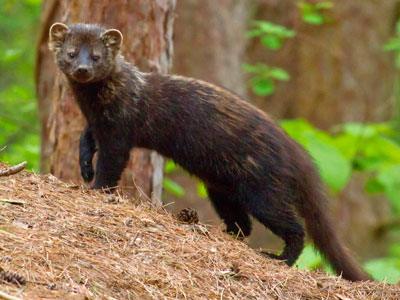Fishers cats

About Fishers
The fisher (Martes pennanti) is the second largest member of the weasel family found in Massachusetts; only the river otter is larger. Although many people call them “fisher cats,” the name is inappropriate. They are neither members of the feline family, nor do they catch fish.
Except during their brief mating season, fishers are solitary creatures and are active during night and day throughout the year.
Identification
As with other members of the weasel family, fishers have a long, low profile when moving along the ground. They average 32 to 40 inches in length, including a tapering, 12 to 16-inch tail.
The males are considerably larger than the females. The legs of a fisher are short and stout and their feet possess retractable claws, which they use for climbing. A fisher’s coat is dark brown, dense, and glossy.
Historical Background
Fishers were extirpated from much of the northeast in the 1700s and 1800s when loggers and farmers cleared the forests and unregulated trapping took its toll. During the late 1800s, as farms were abandoned and the land became reforested, fisher numbers rebounded.
In the 1950s logging companies, with permission from each state, reintroduced fishers into northern New England to control porcupines. At the time, porcupines were decimating seedlings planted by the timber companies to reestablish trees in logged areas. Fisher is the only species to deliberately target porcupines as prey.
In the east they are now found in southern Canada, New England and New York, and in scattered locations in Pennsylvania, West Virginia, and Virginia. They may be potentially found in practically every community in Massachusetts.
Sounds
For the most part, the members of the Mustelidae, or weasel family, found in New England, are pretty quiet creatures (unless in the grips of a predator) using scent to locate prey. There are also numerous YouTube sites with recordings attributed to screaming fishers, rather than what I believe is the actual vocalist, a red fox.
Food & Diet
For the most part fishers are carnivores, although they will eat berries and fruit when available. They eat rabbits, snowshoe hares, squirrels, raccoons, mice, reptiles, amphibians, insects, carrion (dead or decaying animal flesh), and occasionally house cats. Even though fishers do not catch live fish, they will eat dead fish found on the shore of a lake or pond.
Fishers are one of the few mammals that prey on porcupines. Porcupines are difficult to kill, but a dead porcupine can provide many days of food for a fisher, so it is worth the effort. While on the ground, the fisher continually attacks the only vulnerable portions of the porcupine’s body, its face and underbelly. When facial wounds have weakened the porcupine, the fisher goes in for the kill. To avoid the quills, the fisher eats its prey starting at the head, neck, or underbelly.
Life Cycle
Breeding takes place in March or April when females are 1-2 years old. After a delayed implantation period of 10 or 11 months, the blastocyst (the earliest stage of the embryo) is implanted in the womb, possibly stimulated by changing day length.
Once implanted in the womb the embryo develops in only six weeks. Young fishers are born the following March or early April, and females are able to mate again within just a few days after giving birth.
A litter of 1 to 4 kits is born in a maternity den in a hollow tree. The blind and helpless newborns are dependent on the mother for nearly four months (the male does not help rear the young). Young fishers begin to capture their own prey at four months of age, and disperse by the time they are five months old.
Situations & Solutions
Fishers are secretive and elusive creatures. They keep their distance from humans and do not den under buildings. That being said, fisher sightings have increased significantly since 2000, which may cause concern among homeowners and cat owners. Learn More about how to protect small animals.


nockedup Massachusetts outdoors.